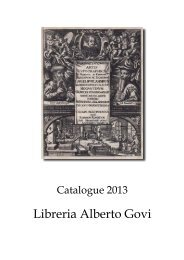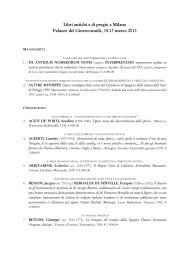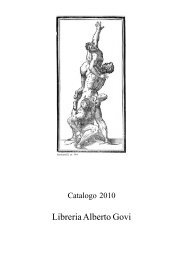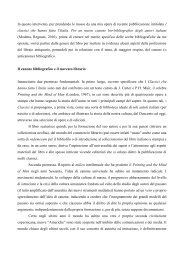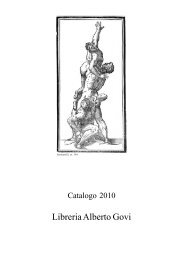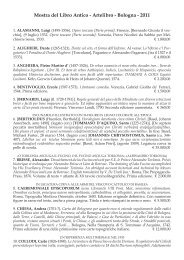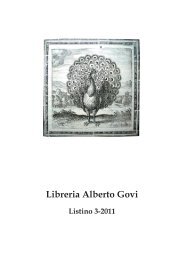List 4-2013 - Libreria Antiquaria Alberto Govi
List 4-2013 - Libreria Antiquaria Alberto Govi
List 4-2013 - Libreria Antiquaria Alberto Govi
Create successful ePaper yourself
Turn your PDF publications into a flip-book with our unique Google optimized e-Paper software.
a m a n e d i t e d B y a w o m a n<br />
9) GONZAGA, Curzio (1536-1599) - CAMPIGLIA, Maddalena ed. (d. 1595). Il Fidamante. Poema eroico dell’Illustriss.<br />
mo Sig. or Curtio Gonzaga, ricorretto da lui, et di nuovo ristampato, aggiuntivi gli argomenti dell’Illustre, & virtuosiss. Signora<br />
Maddalena Campiglia, & con le Moralità d’incerto Autore. Venezia, all’insegna del Leone [Heirs of Curzio Troiano Navò],<br />
1591.<br />
4to; 18 th century vellum over boards, blind-stamped center-piece on both panels, marbled edges, spine with gilt title on a morocco label, green<br />
silk bookmark (front joint skillfully repaired); (4), 235, (1) leaves. Title within an elaborate woodcut border with the author’s portrait at the center<br />
and his emblem (an eagle flying towards the constellation of the Ursa Minor with the motto “E sole altro non haggio”) at the top (the title<br />
border is the same as used in the first edition of the poem, published in Mantua by Giacomo<br />
Ruffinelli in 1582, with two differences: in the first edition the emblem is at the place of the portrait,<br />
while in the upper oval are the Gonzaga’s coat-of-arms). Printer’s device at the end of the<br />
volume. Woodcut capital letters at the beginning of each Canto. The Argomenti are set within<br />
an ornamental woodcut frame. Very light marginal dampstain in the lower outer corner of the<br />
whole volume, otherwise a nice copy.<br />
SECOND EDITION of Il Fidamante, but the FIRST edited by Maddalena Campiglia, who<br />
added brief verse summaries (Argomenti) of her own at the beginning of each Canto. This<br />
is one of the very first books in which a woman played a leading editorial role. For Curzio<br />
Gonzaga, her friend and relative by marriage, Campiglia also wrote the dedicatory letter to his<br />
comedy Gl’inganni (1592) (cf. V. Cox, Women’s writing in Italy, 1400-1650, Baltimore, 2008,<br />
pp. 153-154).<br />
In the undated dedication addressed by Antonio Amici to the duke of Sora, Giacomo<br />
Buoncompagni, is stated that at that time Curzio Gonzaga was still working on his poem and,<br />
although he had already made significant corrections to the text of the first edition, he was not<br />
yet completely pleased with the results. In order to offer to the public the new corrected version<br />
of the poem, Amici contacted Maddalena Campiglia, who was the keeper of all Gonzaga’s<br />
manuscripts. She agreed to edit the publication and contributed with her Argomenti. While<br />
the poem was already under the press in Venice, Gonzaga was brought to that town by some<br />
personal affairs and, although at first reluctant, he finally accepted to supervise the printing process.<br />
- 22 -



